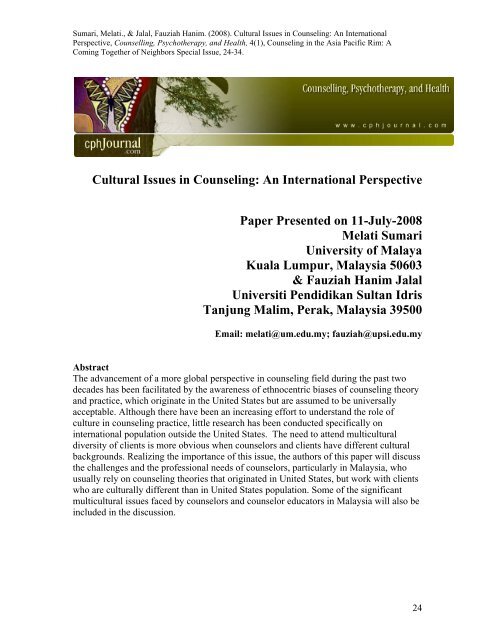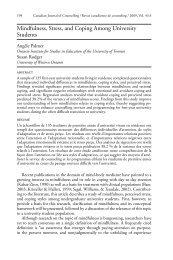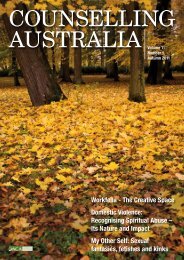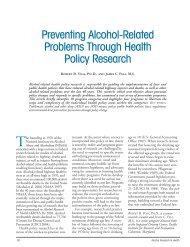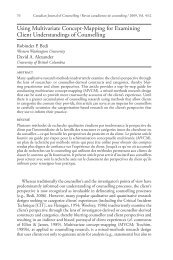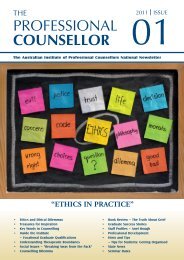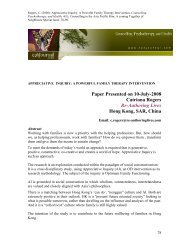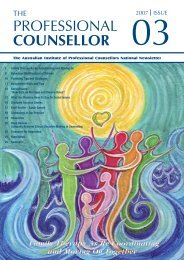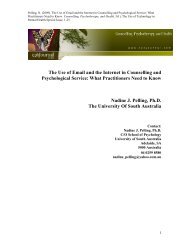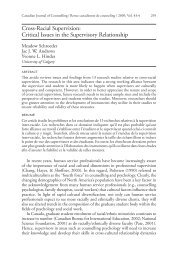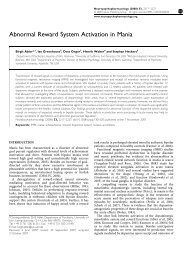Cultural Issues in Counseling - Counselling, Psychotherapy and ...
Cultural Issues in Counseling - Counselling, Psychotherapy and ...
Cultural Issues in Counseling - Counselling, Psychotherapy and ...
You also want an ePaper? Increase the reach of your titles
YUMPU automatically turns print PDFs into web optimized ePapers that Google loves.
Sumari, Melati., & Jalal, Fauziah Hanim. (2008). <strong>Cultural</strong> <strong>Issues</strong> <strong>in</strong> Counsel<strong>in</strong>g: An InternationalPerspective, Counsell<strong>in</strong>g, <strong>Psychotherapy</strong>, <strong>and</strong> Health, 4(1), Counsel<strong>in</strong>g <strong>in</strong> the Asia Pacific Rim: ACom<strong>in</strong>g Together of Neighbors Special Issue, 24-34.<strong>Cultural</strong> <strong>Issues</strong> <strong>in</strong> Counsel<strong>in</strong>g: An International PerspectivePaper Presented on 11-July-2008Melati SumariUniversity of MalayaKuala Lumpur, Malaysia 50603& Fauziah Hanim JalalUniversiti Pendidikan Sultan IdrisTanjung Malim, Perak, Malaysia 39500Email: melati@um.edu.my; fauziah@upsi.edu.myAbstractThe advancement of a more global perspective <strong>in</strong> counsel<strong>in</strong>g field dur<strong>in</strong>g the past twodecades has been facilitated by the awareness of ethnocentric biases of counsel<strong>in</strong>g theory<strong>and</strong> practice, which orig<strong>in</strong>ate <strong>in</strong> the United States but are assumed to be universallyacceptable. Although there have been an <strong>in</strong>creas<strong>in</strong>g effort to underst<strong>and</strong> the role ofculture <strong>in</strong> counsel<strong>in</strong>g practice, little research has been conducted specifically on<strong>in</strong>ternational population outside the United States. The need to attend multiculturaldiversity of clients is more obvious when counselors <strong>and</strong> clients have different culturalbackgrounds. Realiz<strong>in</strong>g the importance of this issue, the authors of this paper will discussthe challenges <strong>and</strong> the professional needs of counselors, particularly <strong>in</strong> Malaysia, whousually rely on counsel<strong>in</strong>g theories that orig<strong>in</strong>ated <strong>in</strong> United States, but work with clientswho are culturally different than <strong>in</strong> United States population. Some of the significantmulticultural issues faced by counselors <strong>and</strong> counselor educators <strong>in</strong> Malaysia will also be<strong>in</strong>cluded <strong>in</strong> the discussion.24
Sumari, Melati., & Jalal, Fauziah Hanim. (2008). <strong>Cultural</strong> <strong>Issues</strong> <strong>in</strong> Counsel<strong>in</strong>g: An InternationalPerspective, Counsell<strong>in</strong>g, <strong>Psychotherapy</strong>, <strong>and</strong> Health, 4(1), Counsel<strong>in</strong>g <strong>in</strong> the Asia Pacific Rim: ACom<strong>in</strong>g Together of Neighbors Special Issue, 24-34.IntroductionA major assumption for culturally sensitive counsel<strong>in</strong>g is that counselors canacknowledge their own tendencies <strong>and</strong> the limit of their cultures on other people. Thus, isessential for counselors to underst<strong>and</strong> their cultures <strong>and</strong> their worldviews before help<strong>in</strong>g<strong>and</strong> assist<strong>in</strong>g other people. Accord<strong>in</strong>g to Padilla, Boxley, <strong>and</strong> Wagner (1973), there, is<strong>in</strong>creas<strong>in</strong>g evidence that the tra<strong>in</strong>ed counselor is not prepared to deal with <strong>in</strong>dividualswho are culturally different from them. Although Padilla et al’s writ<strong>in</strong>g was publishedmore than 20 years ago, the idea is still applicable to current situation. <strong>Cultural</strong> sensitivityrema<strong>in</strong>s as one of the important characteristics of effective counsel<strong>in</strong>g. Padilla et al’swrit<strong>in</strong>g also shows that one of the characteristics of an effective counselor is the ability torecognize diversity <strong>and</strong> cultural differences. It is undeniable that the need to attendmulticultural diversity of clients is more obvious when counselors <strong>and</strong> clients havedifferent cultural backgrounds. Accord<strong>in</strong>g to Pedersen, Draguns, Lonner, <strong>and</strong> Trimble(2002), multicultural awareness is no longer considered as a special emphasis, <strong>in</strong>stead asa generic competence <strong>in</strong> counsel<strong>in</strong>g across cultures. Recogniz<strong>in</strong>g the importance ofcultural awareness <strong>and</strong> cultural sensitivity, more authors <strong>and</strong> researchers who focus theirwork on multicultural counsel<strong>in</strong>g have emphasized the importance of counselorsdemonstrat<strong>in</strong>g multicultural competence <strong>in</strong> work<strong>in</strong>g with diverse population(Constant<strong>in</strong>e, Ladany, Inman, & Ponterotto, 1996). However, it is important to note herethat s<strong>in</strong>ce most counsel<strong>in</strong>g literature stems from research on White Euro-Americansmiddle class, the st<strong>and</strong>ard to determ<strong>in</strong>e mentally healthy or unhealthy is based from theircultural perspectives. Recogniz<strong>in</strong>g the importance of multicultural awareness <strong>in</strong>counsel<strong>in</strong>g, the authors of this paper will discuss some of the key issues <strong>in</strong> multiculturalcounsel<strong>in</strong>g. The discussion will be divided <strong>in</strong>to four sections: (1) Underst<strong>and</strong><strong>in</strong>g SociopoliticalFactors <strong>in</strong> Counsel<strong>in</strong>g; (2) Will Western Model Benefit <strong>in</strong>ternational Population;(3) Challenges Faced by Counselors <strong>in</strong> Malaysia; (4) Recommendations <strong>and</strong> Conclusions.Underst<strong>and</strong><strong>in</strong>g Socio-Political Factors <strong>in</strong> Counsel<strong>in</strong>gIn the United States, m<strong>in</strong>ority people usually refer to ethnic m<strong>in</strong>orities, gays, lesbians,transgender, bisexuals, <strong>and</strong> women. When counsel<strong>in</strong>g is <strong>in</strong>ternationalized <strong>and</strong> becomes amore global field, m<strong>in</strong>ority people can also be referred to any people <strong>in</strong> other countrieswhose culture is different than White American culture.The move to multicultural awareness requires counselors to underst<strong>and</strong> the impact ofsocio-political factors that affect m<strong>in</strong>orities whether they are <strong>in</strong> the United States or <strong>in</strong>other countries. Why? Counsel<strong>in</strong>g should not forget the context where people live <strong>and</strong> thepolitical structure that affects people live (Santos, Ferreira & Chaves, 2001; Sue & Sue,2003) because underst<strong>and</strong><strong>in</strong>g sociopolitical factors help counselors to offer effective<strong>in</strong>terventions from their clients’ cultural context. Counselors must realize that the mentalhealth practice is <strong>in</strong>fluenced by historical <strong>and</strong> current sociopolitical contexts that have animpact on variety of issues, such as race, culture, <strong>and</strong> ethnicity. Sociopolitical dynamicsnot only <strong>in</strong>fluence the worldview of clients but also the worldview of counselors (Sue &Sue, 2003). Ibrahim (1991) noted that “because worldviews are culturally basedvariables, they <strong>in</strong>fluence the relationship between a helper <strong>and</strong> a client” (p. 14), which <strong>in</strong>turn may <strong>in</strong>terfere with counselors’ effectiveness <strong>in</strong> perceiv<strong>in</strong>g <strong>and</strong> <strong>in</strong>terpret<strong>in</strong>g clients’25
Sumari, Melati., & Jalal, Fauziah Hanim. (2008). <strong>Cultural</strong> <strong>Issues</strong> <strong>in</strong> Counsel<strong>in</strong>g: An InternationalPerspective, Counsell<strong>in</strong>g, <strong>Psychotherapy</strong>, <strong>and</strong> Health, 4(1), Counsel<strong>in</strong>g <strong>in</strong> the Asia Pacific Rim: ACom<strong>in</strong>g Together of Neighbors Special Issue, 24-34.problems. For <strong>in</strong>stance, <strong>in</strong> the United States, <strong>in</strong>stitutional racism has created barriersbetween White Americans <strong>and</strong> people of color. Over the last 500 years people of color,especially African Americans, have endured a pattern of state-sanctioned violence, <strong>and</strong>civil <strong>and</strong> human rights abuse <strong>and</strong> have been the victims of systematic public <strong>and</strong>spontaneous private violence s<strong>in</strong>ce the slave trade <strong>and</strong> the colonial conquest of theAmericas. Arab Americans is another misunderstood ethnic group <strong>in</strong> the United States(Erikson & Al-Timimi, 2001). Many Arab Americans perceive the U.S political <strong>and</strong>economical relationships as tak<strong>in</strong>g sides <strong>in</strong> the Arab-Israeli conflict. Furthermore, thepolitical <strong>in</strong>stability <strong>in</strong> their home countries may have caused them to have cautious <strong>and</strong>apprehensive worldview especially towards Western people. They may refuse to speakopenly about their problem <strong>and</strong> do not feel comfortable <strong>in</strong> express<strong>in</strong>g their view. Inaddition to that, negative stereotyp<strong>in</strong>g towards m<strong>in</strong>ority people may lead them to perceiveEuro-American counselors with mistrust <strong>and</strong> suspicious. Sue <strong>and</strong> Sue (2003) noted bynot reveal<strong>in</strong>g their true feel<strong>in</strong>gs, they prevent counselors from know<strong>in</strong>g their th<strong>in</strong>k<strong>in</strong>g,which may protect them from be<strong>in</strong>g offended <strong>and</strong> exploited.Underst<strong>and</strong><strong>in</strong>g sociopolitical dynamics also help counselor to avoid misdiagnosis <strong>and</strong>mistaken assumptions towards clients. Because of common myths <strong>and</strong> misconceptionstowards diverse populations, Euro-American model of counsel<strong>in</strong>g is seen as superior <strong>and</strong>applicable across culture. As highlighted by Sue <strong>and</strong> Sue (2003), White Euro-Americancultures are considered as not only desirable, but normative as well. A culturallycompetent counselor must realize that what is regarded as good <strong>in</strong> one culture may beseen as maladaptive <strong>in</strong> other cultures. In some countries like Ch<strong>in</strong>a <strong>and</strong> Russia, <strong>in</strong>dividualdifferences, freedom of choice, self-determ<strong>in</strong>ation, <strong>and</strong> us<strong>in</strong>g one’s own potential data atsome po<strong>in</strong>ts are prohibited <strong>and</strong> considered as politically <strong>in</strong>correct. Therapeutic helpshave also been politically motivated <strong>and</strong> oppressive (Leung, Guo, & Lam, 2000; O’Neil,1992). To protect their own safety, those who grew up <strong>in</strong> such countries may lack ofverbal expression <strong>and</strong> open communication, which may lead counselor to have mistakenassumptions towards their clients. Clients may be seen as uncooperative, dependent, <strong>and</strong>unable to communicate. European- American counselors or Russian counselors whoreceived their tra<strong>in</strong><strong>in</strong>g <strong>in</strong> the West must be particularly aware that Western counsel<strong>in</strong>gapproaches are not applicable <strong>in</strong> a society where <strong>in</strong>dividual beliefs <strong>and</strong> needs aredeemphasized.Another important reason why it is crucial for counselors to underst<strong>and</strong> socio politicalimpact <strong>in</strong> counsel<strong>in</strong>g is to avoid do<strong>in</strong>g harm on clients <strong>and</strong> ensure that they provideeffective service to client. S<strong>in</strong>ce counsel<strong>in</strong>g occurs <strong>in</strong> a cultural context, the mean<strong>in</strong>g ofcounsel<strong>in</strong>g <strong>and</strong> the role of counselors may vary across cultures. M<strong>in</strong>ority people may lackof confidence <strong>in</strong> the counsel<strong>in</strong>g process conducted by Euro-American counselors as aresult of racial oppression. In some countries which were colonized by Western powers<strong>in</strong> the past, Western model that emphasizes on <strong>in</strong>dividual choice may be seen as anattempt to impose Western st<strong>and</strong>ard <strong>and</strong> way of life on less powerful group <strong>and</strong> an attackto traditional values. While the separation between religion <strong>and</strong> science is clearly stated<strong>in</strong> the West, religious <strong>and</strong> moral teach<strong>in</strong>gs are embedded <strong>in</strong> many areas, such as political,legislative, educational, <strong>and</strong> help<strong>in</strong>g profession. In such countries, counselors are morally26
Sumari, Melati., & Jalal, Fauziah Hanim. (2008). <strong>Cultural</strong> <strong>Issues</strong> <strong>in</strong> Counsel<strong>in</strong>g: An InternationalPerspective, Counsell<strong>in</strong>g, <strong>Psychotherapy</strong>, <strong>and</strong> Health, 4(1), Counsel<strong>in</strong>g <strong>in</strong> the Asia Pacific Rim: ACom<strong>in</strong>g Together of Neighbors Special Issue, 24-34.obligated to help clients make a choice that are not aga<strong>in</strong>st moral <strong>and</strong> religious teach<strong>in</strong>gs.The pressure to accept Western values <strong>and</strong> reject their own may be seen as another formof oppression (<strong>and</strong> colonization) whose role is to force assimilation <strong>and</strong> acculturation(Sue & Sue, 2003). Counselors who wish to avoid do<strong>in</strong>g harm <strong>in</strong> the counsel<strong>in</strong>g processmust consider the potential effects of sociopolitical dynamics. Increased awareness ofthese sociopolitical dynamics allows counselors to view counsel<strong>in</strong>g from a broader <strong>and</strong>deeper perspective, which <strong>in</strong> turn help them to render appropriate services for their clientsWill Western Model Benefit International Population?With the grow<strong>in</strong>g recognition of cultural diversity, it is important to look whether<strong>in</strong>ternational population would or would not benefit from the counsel<strong>in</strong>g models thatwere developed mostly <strong>in</strong> <strong>and</strong> for Western population. Our view is that Western modelsof counsel<strong>in</strong>g would only benefit <strong>in</strong>ternational population with some cultural adaptation<strong>and</strong> accommodation. In addition to that, counsel<strong>in</strong>g researchers must beg<strong>in</strong> to developtheoretical models that suite to <strong>in</strong>ternational population.Why counsel<strong>in</strong>g <strong>in</strong> the Western sense will never take place <strong>in</strong> other societies whoseculture is different than Western culture? Simple importation of Western models ofcounsel<strong>in</strong>g models with expectations of similar results may never happen due to culturaldifferences. In discuss<strong>in</strong>g the limitations of career counsel<strong>in</strong>g Gybers, Heppner, <strong>and</strong>Johnson (1998) noted that the field of counsel<strong>in</strong>g has been founded largely on aframework of European American culture that plays a big role <strong>in</strong> <strong>in</strong>fluenc<strong>in</strong>g theory,research, <strong>and</strong> practice. Two tenets of European American culture that dom<strong>in</strong>atecounsel<strong>in</strong>g literature <strong>and</strong> may limit its adaptability to <strong>in</strong>ternational populations are<strong>in</strong>dividualism <strong>and</strong> autonomy <strong>and</strong> ethnocentrism.The importance of <strong>in</strong>dividuals is obvious <strong>in</strong> counsel<strong>in</strong>g theories as well as counsel<strong>in</strong>g<strong>in</strong>terventions. To ensure that <strong>in</strong>dividuals perform their developmental tasks successfully,they are supposed to separate themselves from their family. As a result, Westerncounsel<strong>in</strong>g or therapy literature often ignores the role of the family that may play asignificant role <strong>in</strong> other cultures. Even some family counsel<strong>in</strong>g approaches alsoemphasize on <strong>in</strong>dividuality. For <strong>in</strong>stance, family of orig<strong>in</strong> therapy (Bowen, 1974) <strong>and</strong>structural therapy (M<strong>in</strong>uch<strong>in</strong>, 1978) propose differentiation of the self from theattachment figures <strong>and</strong> open <strong>and</strong> direct communication among family members. Role <strong>and</strong>boundaries are supposed to be clear so that young adults can leave home <strong>and</strong> achieve<strong>in</strong>dependence. Enmeshment is described as unhealthy because it leads to closeness <strong>and</strong>dependency. What is viewed as healthy <strong>and</strong> adaptive behaviors <strong>in</strong> Western culture maybe viewed as harmful to the family systems <strong>in</strong> other cultures. In collectivist groups,preserv<strong>in</strong>g family harmony is possibly more important than fulfill<strong>in</strong>g personal desires.Roles <strong>and</strong> rules are often unchangeable. Verbal expressiveness <strong>and</strong> direct communicationare less commonly seen. For <strong>in</strong>stance, <strong>in</strong> Lat<strong>in</strong>o <strong>and</strong> Asian Americans families, the needto respect <strong>and</strong> follow family desires is more important than fulfill<strong>in</strong>g <strong>in</strong>dividual <strong>in</strong>terests(Brown, 2004). In Muslim families, preservation of family ties <strong>and</strong> collectivist behaviorcome before <strong>in</strong>dividualistic orientation <strong>and</strong> behavior (Daneshpour, 1998). In thesem<strong>in</strong>ority groups, when an <strong>in</strong>dividual is <strong>in</strong>dividuated from the support network, he or she27
Sumari, Melati., & Jalal, Fauziah Hanim. (2008). <strong>Cultural</strong> <strong>Issues</strong> <strong>in</strong> Counsel<strong>in</strong>g: An InternationalPerspective, Counsell<strong>in</strong>g, <strong>Psychotherapy</strong>, <strong>and</strong> Health, 4(1), Counsel<strong>in</strong>g <strong>in</strong> the Asia Pacific Rim: ACom<strong>in</strong>g Together of Neighbors Special Issue, 24-34.may create a problem to the system because one’s self-image is usually determ<strong>in</strong>ed on thebasis of his relationship with the family (Daneshpour, 1998). In other words, preserv<strong>in</strong>gfamily harmony is much more important than fulfill<strong>in</strong>g <strong>in</strong>dividuals’ needs. As a result,<strong>in</strong>dividuals may not choose a career that fits her personality if they found that the choiceis not approved by the family.The second tenet is ethnocentrism. In an article entitled “Counsel<strong>in</strong>g <strong>in</strong> an <strong>in</strong>ternationalcontext”, Pederson <strong>and</strong> Leong (1997) noted that is a human tendency natural <strong>in</strong> everynation <strong>in</strong>clud<strong>in</strong>g the United States. US models of counsel<strong>in</strong>g generally are based on theworks of US researchers <strong>and</strong> the models generally are more adaptable to Whitepopulation (Corey, 2008). Many researchers have agreed that counsel<strong>in</strong>g as traditionallypracticed <strong>in</strong> the United States might lead to dangerous outcomes (Geiste<strong>in</strong> & Egisdottir,2005). Geiste<strong>in</strong> <strong>and</strong> Egisdottir po<strong>in</strong>ted out some examples of the way counselorscommunicate with clients (one-on-one, personal distance, give giv<strong>in</strong>g, <strong>and</strong> batter<strong>in</strong>g) thatare considered ethical <strong>in</strong> US but might be perceived negatively by people from othercultures who take great pride <strong>in</strong> their own unique cultures. Some counsel<strong>in</strong>g <strong>in</strong>terventionsthat use tests <strong>and</strong> <strong>in</strong>struments also are not culturally sensitive. For <strong>in</strong>stance, career teststhat are used widely <strong>in</strong> career counsel<strong>in</strong>g. Fouad <strong>and</strong> B<strong>in</strong>gham (1995) noted that theDISCOVER, the well-known computerized career <strong>in</strong>formation system has no questionthat exam<strong>in</strong>e the role of family <strong>in</strong> career decision-mak<strong>in</strong>g. Vocational PreferenceInventory (VPI) developed by Holl<strong>and</strong> is another example of career test that is notculturally sensitive to non-White. In test<strong>in</strong>g the cross-cultural validity of Holl<strong>and</strong>’s theory<strong>in</strong> India, Leong, Aust<strong>in</strong>, Sekaran, <strong>and</strong> Komaraju (1998) used the Vocational PreferenceInventory (VPI) <strong>and</strong> found that the caste system plays an important role <strong>in</strong> vocational<strong>in</strong>terest. The authors found that the VPI could not be adapted directly to Indian peoplebecause the caste system is highly <strong>in</strong>tegrated <strong>in</strong> their career choice. In this case,vocational <strong>in</strong>terest based on European model of career counsel<strong>in</strong>g is challenged. Many ofthe participants would not complete the VPI as <strong>in</strong> the orig<strong>in</strong>al version because the<strong>in</strong>strument listed some occupations that were considered too low for their caste. Toaddress this cultural issue, the authors changed the word<strong>in</strong>g of the <strong>in</strong>struments <strong>and</strong><strong>in</strong>cluded a category of occupations that considered too low status for them to consider.Even with the modifications, the study concluded that the f<strong>in</strong>d<strong>in</strong>gs did not support thereliability, external, <strong>and</strong> predictive validity of the VPI to Indians. The assumptionsunderly<strong>in</strong>g the theoretical framework of Western career theories that <strong>in</strong>dividuals whowork hard will be able to make any occupational dream a reality is also violated <strong>in</strong> theformer Soviet Union (Skorikov & Vondracek (1993). In the former Soviet system, careerdevelopment of employees was <strong>in</strong>fluenced by nationality, gender, Communist Partymembership, <strong>and</strong> personal relationship. An <strong>in</strong>verse relationship existed between jobperformance <strong>and</strong> satisfaction. The better an employee performs his work, the lower hisjob satisfaction. This was the case because the system of career management was set upaga<strong>in</strong>st people who strive to achieve their occupational dreams. Even though some<strong>in</strong>struments have been proven to work well <strong>and</strong> adaptable <strong>in</strong> other cultures, the factrema<strong>in</strong>s that they were orig<strong>in</strong>ally developed for Western population. Similar to potentialproblems of employ<strong>in</strong>g US models of counsel<strong>in</strong>g <strong>in</strong>terventions is the use of a USdiagnostics system, the American Psychiatric Association’s (1994) Diagnostics <strong>and</strong>28
Sumari, Melati., & Jalal, Fauziah Hanim. (2008). <strong>Cultural</strong> <strong>Issues</strong> <strong>in</strong> Counsel<strong>in</strong>g: An InternationalPerspective, Counsell<strong>in</strong>g, <strong>Psychotherapy</strong>, <strong>and</strong> Health, 4(1), Counsel<strong>in</strong>g <strong>in</strong> the Asia Pacific Rim: ACom<strong>in</strong>g Together of Neighbors Special Issue, 24-34.Statistical Manual of Mental Disorder-IV (DSM-IV), which are used widely <strong>in</strong> Malaysiaespecially by psychiatrists.Based on the discussion presented <strong>in</strong> this section about the potential hazard of adopt<strong>in</strong>gUS models, it is important for counsel<strong>in</strong>g professionals across the globe to be aware ofthe issue. Why <strong>in</strong>ternational populations would not benefit from Western counsel<strong>in</strong>gmodels? Individuals cannot be separated from their society <strong>and</strong> the cultural context <strong>in</strong>where they were born <strong>and</strong> raised. Sue <strong>and</strong> Sue (2002) noted that <strong>in</strong>dividuals who sharethe same cultural matrix would exhibit similar values <strong>and</strong> beliefs systems. These values<strong>and</strong> beliefs systems will then <strong>in</strong>fluence their worldviews. A broader view of counsel<strong>in</strong>gdevelopment must not ignore the different world views <strong>and</strong> cultural values. We cannotsimply develop a counsel<strong>in</strong>g model that can be used by all <strong>in</strong>dividuals without tak<strong>in</strong>g <strong>in</strong>toaccount the cultural context.Challenges faced by Counselors <strong>in</strong> MalaysiaMalaysia is a culturally <strong>and</strong> religiously diverse country with about 26.26 million peopleconsist<strong>in</strong>g of 65.1% Malays <strong>and</strong> other <strong>in</strong>digenous groups, 26% Ch<strong>in</strong>ese, <strong>and</strong> 7.7%Indians (Malaysian Department of Statistic, 2005). As revealed <strong>in</strong> the MalaysianPopulation <strong>and</strong> Hous<strong>in</strong>g Census 2000, religion is also highly correlated with ethnicity.Most Malays are Muslims; most Ch<strong>in</strong>ese are Buddhists; <strong>and</strong> most Indians are H<strong>in</strong>du.Be<strong>in</strong>g a multi-religious nation, Malaysia also has a fair share of those embrac<strong>in</strong>g otherreligions, such as Christianity, Taoism <strong>and</strong> other traditional Ch<strong>in</strong>ese religions (MalaysianDepartment of Statistics, 2005). In East Malaysia, many of the <strong>in</strong>digenous people areChristians, although traditional beliefs are also widely practiced. Because of its culturalmix, many Malaysians are multil<strong>in</strong>gual. Many can speak at least two languages; Malay asa first language <strong>and</strong> English as a second language. Other languages used by Malaysians<strong>in</strong>clude Ch<strong>in</strong>ese <strong>and</strong> Tamil.Like many other Asian societies, Malaysian is also a collectivist society, whichemphasizes the values of group over the <strong>in</strong>dividual. Although each ethnic group has itsown cultural traditions <strong>and</strong> community structures, their cultures have blended together asa result of socialization. For <strong>in</strong>stance, many elements of the Indian culture have beenadopted <strong>in</strong>to the Malay culture. The most obvious example is the Malay marriageceremony, which was adopted from Indian marriage ceremony. The “bers<strong>and</strong><strong>in</strong>g”ceremony, which the bride <strong>and</strong> his groom wear special dress <strong>and</strong> seat on the bridal couchthat has been decorated was adopted from Indian culture. The couple is treated as royalty.The Malays have also adopted a Ch<strong>in</strong>ese custom of giv<strong>in</strong>g “ang pow” or money giftwrapped <strong>in</strong> colored envelopes to children dur<strong>in</strong>g “Syawal”, which is a celebration held tocommemorate the completion of the fast<strong>in</strong>g month of “Ramadhan”.\The Malays are the majority <strong>and</strong> they make up more than half (65%) of the population(Malaysian Department of Statistics, 2005). Most of the Malays are Muslims. Under theMalaysian Federal Constitution, the term “Malay” is def<strong>in</strong>ed as a person who practicesMalay culture <strong>and</strong> professes the religion of Islam, speaks Malay language, <strong>and</strong> whoseancestors are Malay (Wikipedia, 2006).29
Sumari, Melati., & Jalal, Fauziah Hanim. (2008). <strong>Cultural</strong> <strong>Issues</strong> <strong>in</strong> Counsel<strong>in</strong>g: An InternationalPerspective, Counsell<strong>in</strong>g, <strong>Psychotherapy</strong>, <strong>and</strong> Health, 4(1), Counsel<strong>in</strong>g <strong>in</strong> the Asia Pacific Rim: ACom<strong>in</strong>g Together of Neighbors Special Issue, 24-34.The Ch<strong>in</strong>ese constitute about 26% of the population. Most of them are descendents ofCh<strong>in</strong>ese immigrants who arrived between the 17 th <strong>and</strong> 19 th century. The Ch<strong>in</strong>ese are amixture of Buddhists, Taoists, Confucians, <strong>and</strong> Christians. Some Malaysian Ch<strong>in</strong>esespeak English as their first language although the majority of them are Ch<strong>in</strong>ese speak<strong>in</strong>g(Wikipedia, 2006)The Indians are the third largest ethnic group, which form about 7.7% of the population.The majority of Indians descended from those who migrated from South India dur<strong>in</strong>g theBritish colonization. Most Indians speak Tamil as a first language. Approximately, 80%of Indians identify themselves as H<strong>in</strong>dus (Wikipedia, 2006) while the others are Muslimsor Christians (Storz, 1999).The oldest <strong>in</strong>habitants of Malaysia are the <strong>in</strong>digenous groups, who mostly reside <strong>in</strong> EastMalaysia, <strong>and</strong> the aborig<strong>in</strong>es of the Pen<strong>in</strong>sular Malaysia. The groups account for about5% of the population. These groups generally share a strong spiritual tie to the ra<strong>in</strong>forest(Malaysia Tourism Promotion Board, 2006). There are more than 95 different <strong>in</strong>digenous<strong>and</strong> aborig<strong>in</strong>al groups, each with their own cultural identity.Despite the diversity, Malaysia is a harmonious county with multiracial groups liv<strong>in</strong>gtogether. However, like many multiracial society, Malaysia also faces some issues relatedto multicultural even though racial tension is rarely voiced. Counselors <strong>and</strong> counsel<strong>in</strong>gfaculty may face some significant multicultural issues as an impact of these sociopoliticaldynamics. They may <strong>in</strong>evitably encounter client populations that differ from themselves.Such situation may no create a problem if they underst<strong>and</strong> that all behaviors are learned<strong>and</strong> displayed <strong>in</strong> a cultural context. However, it is important to note here that Malaysians’perspective towards counsel<strong>in</strong>g or mental health service is different than Westernpeople’s perspective. The stigma towards mental health problem is very much prevail<strong>in</strong>gamong the general population regardless of their educational backgrounds (Crabtree &Chong, 2000; Kumaraswamy, 2001). S<strong>in</strong>ce the <strong>in</strong>dependence from the British colony <strong>in</strong>1957, the country only recorded one race riot that happened on May 13, 1969, <strong>in</strong>volv<strong>in</strong>gmajority people who are Malays <strong>and</strong> m<strong>in</strong>ority Ch<strong>in</strong>ese, who were considered immigrants.In 1971, the government announced that racial sensitive issues were not openly discussedunder any circumstances. The government also <strong>in</strong>troduced many policies that aim to unitethe country. On the surface, Malaysia is a harmonious county with multiracial groupsliv<strong>in</strong>g together. Racial tension is rarely voiced. However, this does not mean that racial<strong>and</strong> cultural issues have been solved. Consider<strong>in</strong>g this issue, what are some of thechallenges that counselors <strong>and</strong> counselor educators <strong>in</strong> Malaysia may face?These sociopolitical dynamics are challenges for counselors <strong>and</strong> counselor educators <strong>in</strong>Malaysian universities. Perhaps the biggest challenge or issue for counselor educators isto have honest <strong>and</strong> open discussions on multicultural issues, even <strong>in</strong> the MulticulturalCounsel<strong>in</strong>g class because such discussion is not encouraged to avoid racial tension.Usually, the discussions are kept at the surface level. For some counselor educators whohad exposure to multicultural issues dur<strong>in</strong>g their tra<strong>in</strong><strong>in</strong>g <strong>in</strong> Western countries, they30
Sumari, Melati., & Jalal, Fauziah Hanim. (2008). <strong>Cultural</strong> <strong>Issues</strong> <strong>in</strong> Counsel<strong>in</strong>g: An InternationalPerspective, Counsell<strong>in</strong>g, <strong>Psychotherapy</strong>, <strong>and</strong> Health, 4(1), Counsel<strong>in</strong>g <strong>in</strong> the Asia Pacific Rim: ACom<strong>in</strong>g Together of Neighbors Special Issue, 24-34.realize the importance of such discussions, but they may feel uncomfortable to have opendiscussions. It may also be difficult to discuss multicultural issues with some counselors<strong>and</strong> counselor educators, who never been exposed to open racial discussions. Majoritypeople may refuse to discuss racial issues because they do not want their privileges as amajority to be challenged. On the other h<strong>and</strong>, m<strong>in</strong>ority people may also refuse to talkabout it openly to avoid racial conflicts. As noted by Sue <strong>and</strong> Sue (2003), prejudice <strong>and</strong>suspicious among races may discourage people to have an honest discussion. Sue <strong>and</strong> Suealso emphasized that m<strong>in</strong>ority people will feel more vulnerable <strong>in</strong> discussions that lead toself-disclosure. It is also a challenge to make some people underst<strong>and</strong> that racial or groupprivileges may become a big barrier <strong>in</strong> counsel<strong>in</strong>g relationship. If people from differentraces have open <strong>and</strong> honest discussions regard<strong>in</strong>g privileges of certa<strong>in</strong> groups, they maybetter underst<strong>and</strong><strong>in</strong>g of themselves <strong>and</strong> other people, which is crucial <strong>in</strong> develop<strong>in</strong>g ahealthy help<strong>in</strong>g relationship.The second issue is to apply counsel<strong>in</strong>g theory, techniques, <strong>and</strong> <strong>in</strong>terventions to diversepopulations. Many Malays who are mostly Muslims are suspicious towards anyth<strong>in</strong>g thatis orig<strong>in</strong>ated <strong>in</strong> Western countries after be<strong>in</strong>g colonized by British for nearly threedecades. Western countries are often labeled as evil <strong>and</strong> are try<strong>in</strong>g to underm<strong>in</strong>e theircultural traditions. Even though counsel<strong>in</strong>g has been redeveloped <strong>in</strong> the Malaysiancontext to <strong>in</strong>corporate aspects of Malaysian culture (Pope, Musa, S<strong>in</strong>garavelu, Br<strong>in</strong>gaze,& Russell et al, 2002), there has been little effort to promote the importance ofunderst<strong>and</strong><strong>in</strong>g religious diversity <strong>in</strong> counsel<strong>in</strong>g. Pope, et al (2002) highlighted that for theMalays, religion is very important <strong>and</strong> guides all of their decisions throughout their lives.Unfortunately, many counselor educators have lack of tra<strong>in</strong><strong>in</strong>g <strong>in</strong> multicultural issues <strong>and</strong>were more exposed to Euro-American counsel<strong>in</strong>g theory, research, <strong>and</strong> practice as theyare written <strong>and</strong> practiced <strong>in</strong> the United States. The challenge for counselor educators is todeconstruct counsel<strong>in</strong>g <strong>in</strong> a cultural context by modify the traditional counsel<strong>in</strong>gapproach to a more effective <strong>and</strong> accurate cross-cultural approach. The <strong>in</strong>corporation ofreligion <strong>and</strong> spirituality <strong>in</strong>to counsel<strong>in</strong>g is one of the possible ways to tackle this issue.Because there is a very little room to discuss racial issues dur<strong>in</strong>g the tra<strong>in</strong><strong>in</strong>g <strong>and</strong> theunawareness of multicultural counsel<strong>in</strong>g, the impact of sociopolitical dynamics <strong>in</strong>counsel<strong>in</strong>g may be not be well understood <strong>and</strong> recognized by student counselors. Asmentioned previously, lack of underst<strong>and</strong><strong>in</strong>g of sociopolitical dynamics may limitcounselors’ ability to better underst<strong>and</strong> the worldviews of clients from other culturalbackgrounds <strong>and</strong> cause misconceptions <strong>and</strong> misdiagnosis. Whether counselors realize ornot, they may do harm to clients rather than help them f<strong>in</strong>d<strong>in</strong>g the best way to face theirproblems. In conclusion, counselor educators work<strong>in</strong>g <strong>in</strong> a multiracial society are<strong>in</strong>evitably encounter client populations that differ from themselves. Such situation mayno create a problem if they underst<strong>and</strong> that all behaviors are learned <strong>and</strong> displayed <strong>in</strong> acultural context. Underst<strong>and</strong><strong>in</strong>g political dynamics is vital to successful multiculturalcompetence.31
Sumari, Melati., & Jalal, Fauziah Hanim. (2008). <strong>Cultural</strong> <strong>Issues</strong> <strong>in</strong> Counsel<strong>in</strong>g: An InternationalPerspective, Counsell<strong>in</strong>g, <strong>Psychotherapy</strong>, <strong>and</strong> Health, 4(1), Counsel<strong>in</strong>g <strong>in</strong> the Asia Pacific Rim: ACom<strong>in</strong>g Together of Neighbors Special Issue, 24-34.Recommendations <strong>and</strong> ConclusionsOne of the important questions that we would like to highlight is whether counsel<strong>in</strong>gshould be <strong>in</strong>ternationalized? Many counsel<strong>in</strong>g researchers have agreed on<strong>in</strong>ternationaliz<strong>in</strong>g counsel<strong>in</strong>g. However, <strong>in</strong> the application of cross cultural models,researchers <strong>and</strong> practitioners must be particularly aware that assumptions of culturalidentity cannot be based solely on the country of orig<strong>in</strong> (Hesketh & Rounds, 1995).Migration <strong>and</strong> <strong>in</strong>ternational adoption may change the <strong>in</strong>dividuals’ cultural values <strong>and</strong>they adopt the new culture. Thus, it is critical for counselors to take <strong>in</strong>to account<strong>in</strong>dividual differences with<strong>in</strong> the cultural context. By acknowledg<strong>in</strong>g <strong>in</strong>dividualdifference, counselors can ensure that any modification or accommodation of careertheories <strong>and</strong> development is sensitive to diverse needs of <strong>in</strong>dividuals.A broader view of counsel<strong>in</strong>g theory is the one who is developed from the perspective ofparticular populations <strong>and</strong> is used for those populations. It is unethical to exam<strong>in</strong>e an<strong>in</strong>dividual’s development from a Eurocentric approach because the results may show thathe or she does not perform stage-appropriate developmental tasks. <strong>Cultural</strong>ly sensitivecounselors must acknowledge the danger of stereotyp<strong>in</strong>g <strong>and</strong> the need to respect culturaldiversity. It is impossible to develop a new theory that can be applied for all people, but itis possible to develop a broader view of career theories <strong>and</strong> development throughmodification <strong>and</strong> accommodation of the exist<strong>in</strong>g theories or develop a new one that ismore culturally appropriate. To do so, future researchers are recommended to (1) try toidentify which components of specific theories are universal <strong>and</strong> which one which mayneed to change; (2) gather more <strong>in</strong>formation about the national <strong>and</strong> culturalcharacteristics of the research participants; (3) test theories <strong>in</strong> cultures other than wherethey were orig<strong>in</strong>ally developed; (4) participate <strong>in</strong> mult<strong>in</strong>ational <strong>and</strong> multicultural researchteams; (5) study literatures from other countries; <strong>and</strong> (6) visit foreign countries <strong>and</strong>experience first h<strong>and</strong> differences that exist. By consider<strong>in</strong>g these six recommendations,researchers not only widen their global view, but also help <strong>in</strong> enrich<strong>in</strong>g the literature witha more useful <strong>and</strong> mean<strong>in</strong>gful framework of counsel<strong>in</strong>g development.ReferencesBrown, M.T. (2004). The career development <strong>in</strong>fluence of family of orig<strong>in</strong>:Considerations of race/ethnic group membership <strong>and</strong> class. The Counsel<strong>in</strong>gPsychologist, 32, 587-595.Corey, G. (2008). Theory <strong>and</strong> practice of counsel<strong>in</strong>g <strong>and</strong> psychotherapy. Thous<strong>and</strong> Oaks;CA: Brooks Cole.Crabtree, S. A., & Chong, G. (2000). Mental health <strong>and</strong> citizenship <strong>in</strong> Malaysia.International Social Work, 43, 217-226.Constant<strong>in</strong>e, M. G., Ladany, N., Inman, A. G., & Ponterotto, J. G. (1996). Students’perceptions of multicultural tra<strong>in</strong><strong>in</strong>g <strong>in</strong> counsel<strong>in</strong>g psychology programs. Journalof Multicultural Counsel<strong>in</strong>g <strong>and</strong> Development, 24, 241-253.Daneshpour, M. (1998). Muslim families <strong>and</strong> family therapy. Journal of Marital <strong>and</strong>Family Therapy, 24, 353-390.32
Sumari, Melati., & Jalal, Fauziah Hanim. (2008). <strong>Cultural</strong> <strong>Issues</strong> <strong>in</strong> Counsel<strong>in</strong>g: An InternationalPerspective, Counsell<strong>in</strong>g, <strong>Psychotherapy</strong>, <strong>and</strong> Health, 4(1), Counsel<strong>in</strong>g <strong>in</strong> the Asia Pacific Rim: ACom<strong>in</strong>g Together of Neighbors Special Issue, 24-34.Erikson, C. D., & Al-Timimi, N. R. (2001). Provid<strong>in</strong>g mental health services to ArabAmericans: Recommendations <strong>and</strong> considerations. <strong>Cultural</strong> Diversity <strong>and</strong> EthnicM<strong>in</strong>ority Psychology, 7, 308-327.Fouad, N. A., & B<strong>in</strong>gham, R. P. (1995). Career counsel<strong>in</strong>g with racial <strong>and</strong> ethnicm<strong>in</strong>orities. In W. B. Walsh & S. H. Osipow (Eds.), H<strong>and</strong>book of vocationalpsychology (pp. 331-365). Mahwah, NJ: Lawrence Erlbaum.Gerste<strong>in</strong>, L., & Egisdottir, S. (2005). A trip around the world: A counsel<strong>in</strong>g travelogue.Journal of Mental Health counsel<strong>in</strong>g, 27, 95-103.Gybers, N. C., Heppner, M. J. & Johnston, J. A. (1998). Career counsel<strong>in</strong>g: Process,issues, <strong>and</strong> techniques. Neidham Height, MA: Allyn & Bacon.Hesketh, B., & Rounds, J. (1995). International cross-cultural approaches to careerdevelopment. In W. B. Walsh & S. H. Osipow (Eds.), H<strong>and</strong>book of vocationalpsychology (pp. 367-390). Mahwah, NJ: Lawrence ErlbaumIbrahim, F. A. (1991).Contribution of cultural worldview to generic counsel<strong>in</strong>g <strong>and</strong> development.Journal of Counsel<strong>in</strong>g <strong>and</strong> Development, 70, 13-19.Kumaraswamy, N. (2001). <strong>Psychotherapy</strong> <strong>in</strong> an <strong>in</strong>ternational sett<strong>in</strong>g: A Malaysianperspective. Paper presented at the Annual Meet<strong>in</strong>g of the AmericanPsychological Association (109 th . San Francisco, CA, August 24-28, 2001).Retrieved April 23, 2005, from the ERIC database.Leong, F. T. L., Aust<strong>in</strong>, J. T., Sekaran, U. & Komaraju, M. (1998). An evaluation of thecross-cultural validity of Holl<strong>and</strong>’s theory: Career choices by workers <strong>in</strong> India.Journal of Vocational Behavior, 52, 441-455.Leung, S. A., Guo, L., Lam, M. P. (2000). The development of counsel<strong>in</strong>g psychology <strong>in</strong>higher educational <strong>in</strong>stitutions <strong>in</strong> Ch<strong>in</strong>a: Present conditions <strong>and</strong> needs, futurechallenges. The Counsel<strong>in</strong>g Psychologist, 28, 81-99.Malaysian Department of Statistics. (2005). Population <strong>and</strong> hous<strong>in</strong>g census 2000.Retrieved October 12, 2005, from www.statistics.gov.my.Malaysian Tourism Board Promotion. (2006). About Malaysia, truly Asia. Retrieved fromhttp://www.tourism.gov.my.M<strong>in</strong>uch<strong>in</strong>, S. (1974). Families <strong>and</strong> family therapy. Cambridge, MA: Harvard UniversityPress.O’Neil, J. (1992). A counsel<strong>in</strong>g psychologist <strong>in</strong> the USSR as a Fulbright scholar. Paperpresented as the Annual Convention of American Psychological Association(100 th , Wash<strong>in</strong>gton DC, August 14-18, 1992. Retrieved April 23, 2005, from theERIC database.Padilla, E. R. , Boxley, A., & Wagner, N. (1973). The desegregation of cl<strong>in</strong>icalpsychology tra<strong>in</strong><strong>in</strong>g. Professional Psychology, 4, 259-263.Pederson, P. (1976). The field of <strong>in</strong>tercultural counsel<strong>in</strong>g. In P. Pedersen, W. J. Lonner &J. G. Draguns (Eds.), Counsel<strong>in</strong>g across cultures. (pp. 17-41). Honolulu, HI:University Press of Hawaii.Pedersen, P., & Leong, F. T. L. (1997). Counsel<strong>in</strong>g <strong>in</strong> an <strong>in</strong>ternational context. TheCounsel<strong>in</strong>g Psychologist. 25, 117-121.Pederson, P. B., Draguns, J. G., Lonner. W. J., & Trimble, J. E. (2002). Multiculturalawareness as a generic competence for counsel<strong>in</strong>g. In P. B. Pedersen, J. G.33
Sumari, Melati., & Jalal, Fauziah Hanim. (2008). <strong>Cultural</strong> <strong>Issues</strong> <strong>in</strong> Counsel<strong>in</strong>g: An InternationalPerspective, Counsell<strong>in</strong>g, <strong>Psychotherapy</strong>, <strong>and</strong> Health, 4(1), Counsel<strong>in</strong>g <strong>in</strong> the Asia Pacific Rim: ACom<strong>in</strong>g Together of Neighbors Special Issue, 24-34.Draguns, W. J. Lonner, & J. E. Trimble (Eds.), Counsel<strong>in</strong>g across cultures (pp.xiii—xix). Thous<strong>and</strong> Oaks, CA: Sage.Pope, M., Musa, M., S<strong>in</strong>gravelu, H., Br<strong>in</strong>gaze, T., & Russell, M. (2002). Fromcolonialism to ultranasionalism: History <strong>and</strong> development of career counsel<strong>in</strong>g <strong>in</strong>Malaysia. Career Development Quarterly, 50, 264-274.Santos, E. J. R., Ferreira, J. A., & Chaves, A. (2001). Implications of sociopoliticalcontext for career service delivery. Career Development Quarterly, 50, 45- 55.Skorikov, V., Vondracek, F. W. (1993). Career development <strong>in</strong> the Commonwealth ofIndependent States. Career Development Quarterly, 41, 314-329.Sue, D. W., & Sue, D. (2003). Counsel<strong>in</strong>g the culturally diverse: Theory <strong>and</strong> practice.New York, NY: John Wiley & Sons.Wikipedia. (2006). History of Malaysia. Retrieved May 25, 2006, fromhttp://en.wikipedia.org/wiki/History_of_Malaysia.34


